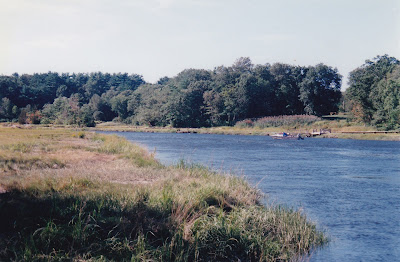 |
| The North River at Union Street, the site of many historic ferries and bridges. |
I’ve been researching the North and South Rivers for close to ten years now. In this time, I’ve learned quite a bit about the history of the rivers and the communities that surround them. Some things I’ve discovered are so timeless or thought-provoking that I feel compelled to write long articles about them, to share what I’ve learned with my readers. Other things I turn up are interesting, sometimes fascinating, but perhaps irrelevant in the long run. Rather than devoting this month’s essay to any one subject, I’d like to take this opportunity to share some of the lesser-known North River facts I’ve come across in my studies.
• At one time there was a large Wampanoag Indian village near the North River in Norwell, near where the Union Street Bridge stands today. A Stone Age Indian site was unearthed in Marshfield in the mid-1960s, but the location was kept secret so that a proper archaeological study could be conducted.
• Missaucatucket, the Wampanoag name for the lands that now comprise Marshfield, can be translated as “at the mouth of the large river.”
• The Columbia, a 212 ton square rigger built in 1773 by James Briggs at Hobart’s Landing on the North River, was the most famous American ship in its time. Captain Robert Gray sailed the Columbia around Cape Horn and up the Pacific to Oregon, to the river that now bears the ship’s name. Marshfield’s Aaron Loomis is our resident specialist on this historically significant sailing vessel.
• In the early twentieth century, the bridges at Union Street and what is now Route 3A were draws, but the one that spanned the river at Damon’s Point was not. When large vessels demanded passage upriver, a work train equipped with a crane was dispatched from Boston to remedy the situation. The central section of the bridge was dismantled — the rails unbolted, the cross ties removed, the heavy timbers swung to the side. After the vessel passed through, the bridge was put back together until the next time. Finally, around 1910 a draw bridge was installed on site.
• The Union Street Bridge has been through several incarnations. The current one was installed in 1961, and was at the time the only electro-hydraulic drawbridge in the United States. It opened and closed well for the first six months of its existence, but has not budged since. Reports indicate that a sand and gravel truck, well within the weight limit, passed over it in June 1961, and damaged a bolt vital to the lifting mechanism. A bolt! The broken bridge made the news over and over again throughout the 1960s, but it has never been repaired. With all the trucks that have passed over the bridge these last four decades, one can only imagine how many other parts of the lifting mechanism are now damaged or missing. . .
• Also in the 1960s, with Route 3 extending all the way to Plymouth and development booming, South Shore towns began to feel the pinch of a water shortage. A solution that was considered in more than one community was the damming of the North River to create reservoirs to refresh the water supply. Can you imagine a dam just below Third Herring Brook near the Hanover-Pembroke-Norwell line, flooding the river valley upstream? Some of our fellow citizens could. I’m happy to report that the towns sought other, better solutions.
• Before the Clean Water Act was enacted in the 1970s, factories were permitted to dump all sorts of waste into rivers and streams. One of the most noteworthy effluents released into a tributary of the North River was refuse from a pickled pig’s feet factory on French’s Stream in Rockland. No wonder people stopped swimming in the river. . .
Pickled pig’s feet seems like a good note to end on. Next time you swim in, boat on, fish from, walk near, or just pass by the North River, consider how clean the river has become in the almost-thirty years since dumping pickled pig juice into our waterways was outlawed.
by Kezia Bacon Bernstein, Correspondent
February 2001
Kezia Bacon Bernstein’s articles appear courtesy of the North and South Rivers Watershed Association, a local non-profit organization devoted to the preservation, restoration, maintenance and conservation of the North and South Rivers and their watershed. For membership information and a copy of their latest newsletter, contact NSRWA at (781) 659-8168.
